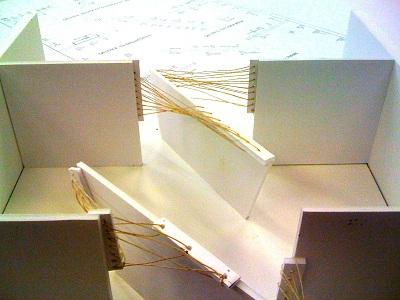As discussed in the previous blog post on the exhibition design of In Wonderland: The Surrealist Adventures of Women in Mexico and the United States, this post will give some the behind the scenes insight as to how the installation process works for a major exhibition.
Typically curators will work with an exhibition designer, either one that is part of the museum staff or hired from outside of the museum. In some cases, artists work on the design plan as was the case with our Magritte and Contemporary Art: The Treachery of Images exhibition in 2006.
After brainstorming with the curator about how the works of art will be installed, an exhibition designer proposes their concept with a floor plan at the first installation design meeting with the director, curator, heads of exhibitions, conservation, construction services, and other involved museum staff where everyone can give their input.
After the initial feedback, the designer might have to refine their concept a couple times. But once the design plans get officially approved at the final installation design meeting, construction services gets started.
In the case of In Wonderland, the Tim Burton retrospective preceded the show. In order to maintain costs and keep under budget, we reused several existing main walls and vitrines, but to give In Wonderland its own unique design, senior exhibition designer Victoria Behner presented this concept:
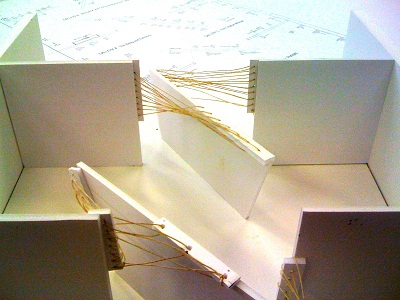 LACMA designer’s original model for the exhibition space
LACMA designer’s original model for the exhibition space
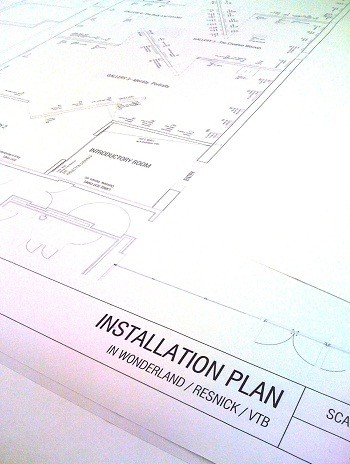 LACMA designer’s original plans for the exhibition space
LACMA designer’s original plans for the exhibition space
Work began in early December, where you can see the shards of walls being built.
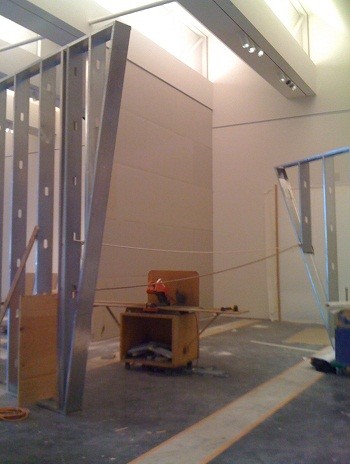 Wall shards in progress
Wall shards in progress
It was also at this time where we experimented with the rope. Inspired by artists like Marcel Duchamp and Maya Deren, the rope was an integral element to Behner’s design. In the installation design meeting, the natural rope was preferred, but conservation pointed out that a rope with natural fibers with fraying ends could pose potential alarm to a painting that has not been glazed (protected with a sheet of glass of Plexiglas over the work). So a synthetic natural-looking rope was opted for instead.
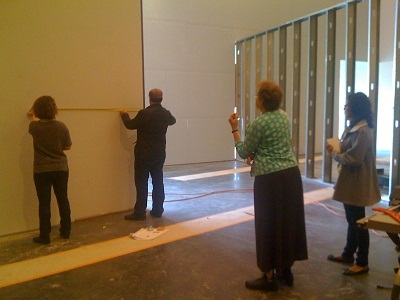 Curator Ilene Susan Fort, graphic designer Jin Son, exhibition designer Victoria Behner, environmental designer Daniel Young discussing the installation progress; Behner, Time Based Media Exhibition Manager Eddy Vajarakitipongse, curator Ilene Susan Fort and Curatorial Assistant Marvella Muro deciding where the exterior for the film should go
Curator Ilene Susan Fort, graphic designer Jin Son, exhibition designer Victoria Behner, environmental designer Daniel Young discussing the installation progress; Behner, Time Based Media Exhibition Manager Eddy Vajarakitipongse, curator Ilene Susan Fort and Curatorial Assistant Marvella Muro deciding where the exterior for the film should go
Since film was also a type of artwork featured in the exhibition, cases were designed to keep much of the light out in order for the public to view the work in. Technicians assist with installing any of the equipment needed for sound or film recordings.
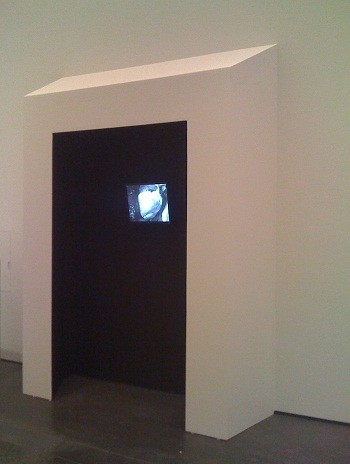 Final exterior case design for Maya Deren’s Witch’s Cradle (1943).
Final exterior case design for Maya Deren’s Witch’s Cradle (1943).
Once the walls are constructed and painted, installation of the actual artwork can begin. It is at least a two-to-three week process, depending on the amount of artwork and couriers scheduled. The Registrar for the exhibition coordinates all the incoming artwork; conservators are also on hand to do the condition reporting of each work once the artwork arrives on the museum premises. After works have been given sufficient time to acclimate upon arrival, they are then installed by the art preparation handlers.
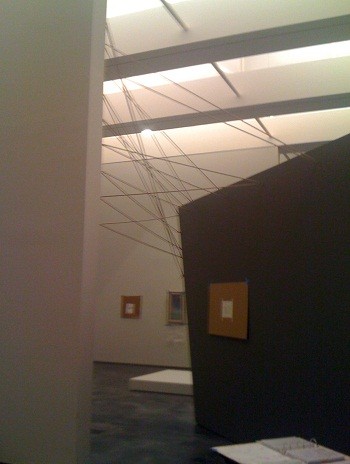 Templates are made for the size of the artwork so curators can play with the positioning of the work in the actual space.
Templates are made for the size of the artwork so curators can play with the positioning of the work in the actual space.
 Ephemeral objects
Ephemeral objects
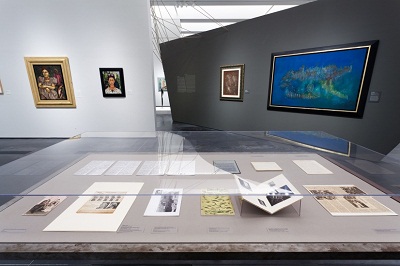 Ephemeral objects under Plexiglas vitrine
Ephemeral objects under Plexiglas vitrine
Ephemeral objects (documentary works to supplement the content of the artwork in the exhibition) are also installed. Paper conservators will prepare the cases and mount them to the case before the Plexiglas vitrine is installed over it.
Once the artwork is installed, labels are affixed to the walls, and any other didactic panels or treatments are installed and/or finalized. Gallery technicians will adjust any of the lighting to make sure the works look their best.
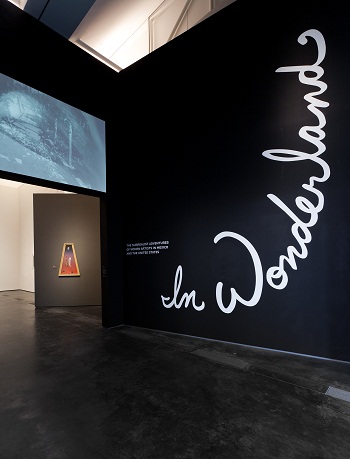 Installation view, In Wonderland: The Surrealist Adventures of Women Artists in Mexico and the United States, January 29-May 6, 2012, Los Angeles County Museum of Art, photo © 2012 Museum Associates/LACMA
Installation view, In Wonderland: The Surrealist Adventures of Women Artists in Mexico and the United States, January 29-May 6, 2012, Los Angeles County Museum of Art, photo © 2012 Museum Associates/LACMA
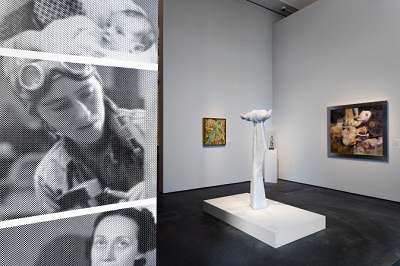 Installation view, In Wonderland: The Surrealist Adventures of Women Artists in Mexico and the United States, January 29-May 6, 2012, Los Angeles County Museum of Art, photo © 2012 Museum Associates/LACMA
Installation view, In Wonderland: The Surrealist Adventures of Women Artists in Mexico and the United States, January 29-May 6, 2012, Los Angeles County Museum of Art, photo © 2012 Museum Associates/LACMA
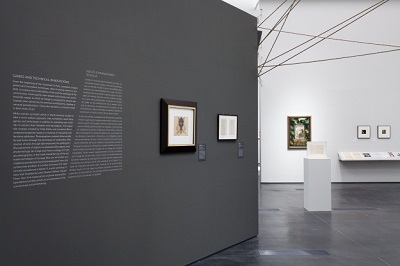 Installation view, In Wonderland: The Surrealist Adventures of Women Artists in Mexico and the United States, January 29-May 6, 2012, Los Angeles County Museum of Art, photo © 2012 Museum Associates/LACMA
Installation view, In Wonderland: The Surrealist Adventures of Women Artists in Mexico and the United States, January 29-May 6, 2012, Los Angeles County Museum of Art, photo © 2012 Museum Associates/LACMA
Conservation will measure light levels to make sure the works are installed under the proper conditions and routinely look over the galleries throughout the exhibition.
Some shots of the complete installation :
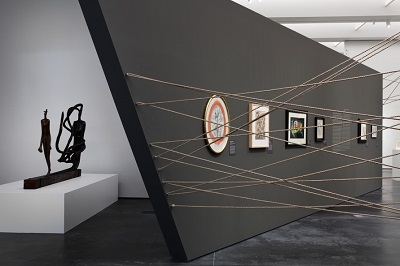 Installation view, In Wonderland: The Surrealist Adventures of Women Artists in Mexico and the United States, January 29-May 6, 2012, Los Angeles County Museum of Art, photo © 2012 Museum Associates/LACMA
Installation view, In Wonderland: The Surrealist Adventures of Women Artists in Mexico and the United States, January 29-May 6, 2012, Los Angeles County Museum of Art, photo © 2012 Museum Associates/LACMA
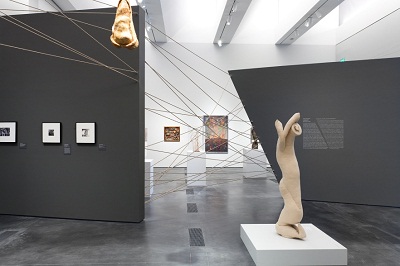 Installation view, In Wonderland: The Surrealist Adventures of Women Artists in Mexico and the United States, January 29-May 6, 2012, Los Angeles County Museum of Art, photo © 2012 Museum Associates/LACMA
Installation view, In Wonderland: The Surrealist Adventures of Women Artists in Mexico and the United States, January 29-May 6, 2012, Los Angeles County Museum of Art, photo © 2012 Museum Associates/LACMA
Devi Noor, Curatorial Administrator, American Art



